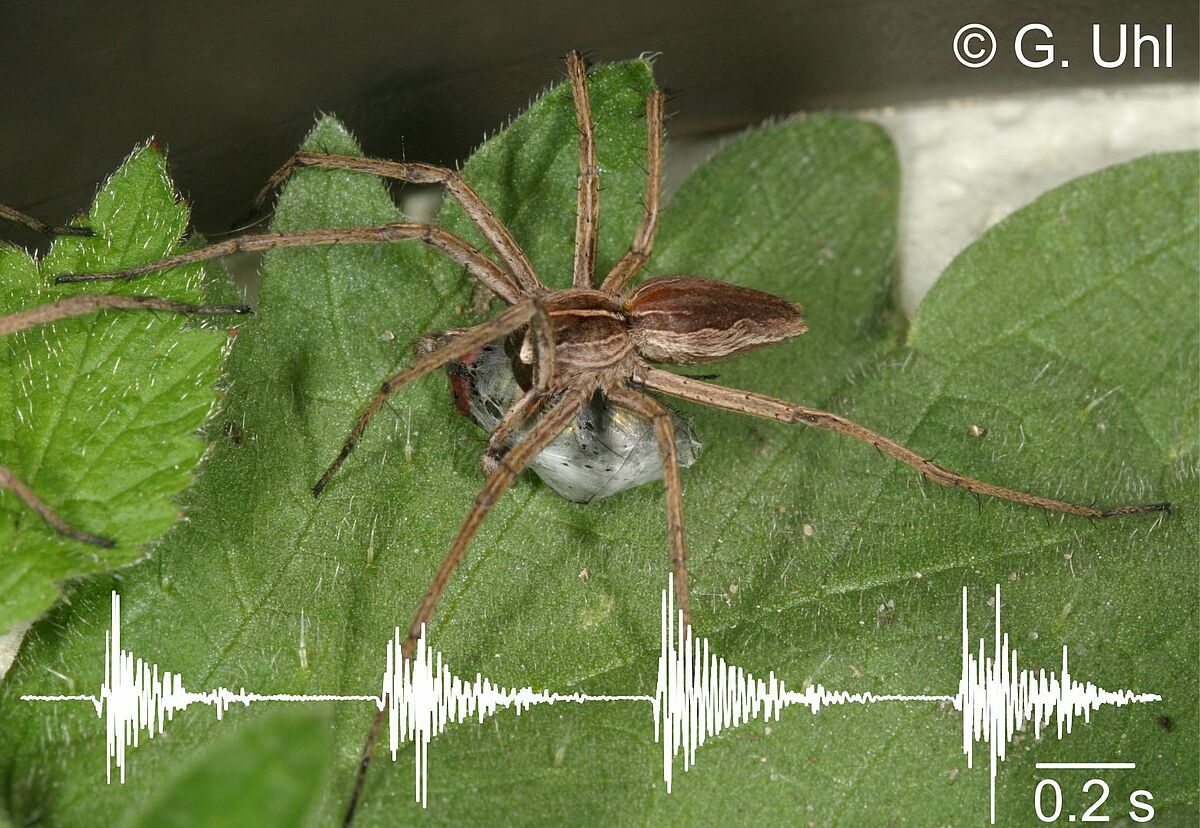Project-related publications
Eberhard, M.J.B.; Möller, T.A.; Uhl, G. 2021. Dragline silk reveals female developmental stage and mediates male vibratory courtship in the nuptial gift‐giving spider Pisaura mirabilis. Ethology 124 :855-861. doi:10.1111/eth.12819 PDF
Eberhard, M.J.B.; Machnis, A.; Uhl, G. 2020. Condition-dependent differences in male vibratory pre-copulatory and copulatory courtship in a nuptial gift-giving spider. Behavioral Ecology and Sociobiology 74: 138. doi.org/10.1007/s00265-020-02918-w. PDF
Project description
Spiders are known to use substrate vibrations in various communication contexts. Sensitive slit sensillae on the legs and other body parts detect these signals. Often, several vibratory signals or signal-components are produced by different production mechanisms, namely percussion, tremulation, and stridulation. Additionally, other communication modalities such as olfaction or vision are used to produce multimodal communication signals.
In the DFG funded project “Chemical and vibratory communication: testing the role of spider silk in a reproductive context” we (Monika Eberhard, Morgan Oberweiser & Gabriele Uhl) investigate vibrational and multimodal signals of Pisaura mirabilis, the nursery web spider, in cooperation with Cristina Tuni, LMU Munich. Similar to various other spider species, nursery web spiders use vibrations during courtship to signal male presence, species identity or quality, and/or to reduce the risk of being attacked by the female (thus being mistaken as prey).
The proposed research will make use of the spider Pisaura mirabilis, a model organism in the study of sexual selection, to uncover the functional roles of chemical and vibratory signals by addressing silk-borne communication between the sexes. Spiders represent an excellent group for studying chemical- and vibratory-based signalling due to their poor vision in most taxa and the production of silk, a key source and/or vehicle of chemicals and vibrations. Through a series of behavioural assays, coupled with structural analyses of silk and measures of male reproductive fitness, we will determine whether and how chemical and vibratory signalling affect reproductive outcomes. We will answer whether signalling is condition and/or state dependent and if individuals employ specific mate choice tactics for partners varying in their signalling efforts. We will also explore the role of silk in facilitating the transmission of chemical and vibratory information contents. We hypothesize that chemical and vibratory signals convey crucial information to the opposite sex in a mating context, with females signalling their location and/or quality to males, and, given the high costs of nuptial gift production for males, males employing specific mate choice tactics for females varying in their reproductive value. The information generated in this interdisciplinary project will shed light on the adaptive nature of multimodal signalling, and fill the knowledge gap on the use of chemical and vibrational channels for reproduction.
In the Bachelor’s projects of Alexandra Machnis and Timon Möller, vibrational signals of P. mirabilis have already been recorded using a Laser-Doppler-Vibrometer in different experimental setups to reveal if signals are related to male quality, nuptial gift presence and size. The Bachelor's project of Paul-Robin Franz explores the importance of vibratory courtship signals for mating and the Master's thesis of Stefan ter Haar investigated if male coursthip vibrations reduce female aggression towards an approaching male.
Collaborations:
Cristina Tuni, Behavioural Ecology, LMU Munich, Germany
Tomer Czaczkes, Evolutionsbiologie, University of Regensburg, Germany
Niels Dingemanse, Behavioural Ecology, LMU Munich, Germany
Biotremology in wasp spiders
In a perspective Bachelor or Master project, substrate-borne vibrational signals of the wasp spider A. bruennichi males (and females) will be recorded using a Laser-Doppler-Vibrometer to assess the intra- and interindividual variability of communication signals during courtship. Recordings in the laboratory and in the field will reveal possible plasticity and impacts of environmental factors on the communication signals. Additionally, morphological parameters of the spiders will be measured to investigate a correlation between certain conditional factors and courtship signals. Please get in contact if interested!

